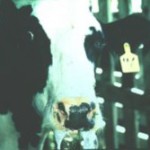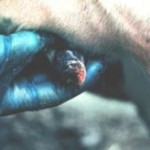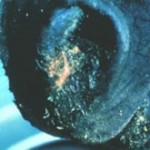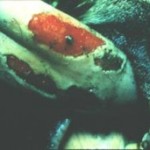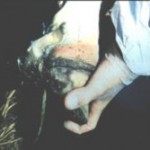What is Vesticular Stomatitis?
Vesicular Stomatitis
Vesicular stomatitis is a viral disease that primarily affects cattle, horses, swine and occasionally sheep and goats. Humans can also become infected with vesicular stomatitis when handling affected animals.
Vesicular stomatitis is most likely to occur during warm months in the Southwest, particularly along riverways and in valleys. The Southwestern United States experienced a vesicular stomatitis outbreak from May 1998 through January 1999. It is essential that veterinarians and livestock owners be on the alert for animals displaying clinical signs characteristic of the disease.
In affected livestock, vesicular stomatitis causes blisterlike lesions to form in the mouth and on the dental pad, tongue, lips, nostrils, hooves, and teats. These blisters swell and break, leaving raw tissue that is so painful that infected animals generally refuse to eat or drink and show signs of lameness. Severe weight loss usually follows, and in dairy cows, a severe drop in milk production commonly occurs. Affected dairy cattle can appear to be normal and will continue to eat about half of their feed intake.
Epidemiology:
Vesicular stomatitis has been confirmed only in North and South America. It is known to be an endemic disease in the warmer regions of the Western Hemisphere, but outbreaks of the disease occasionally occur in temperate geographic areas.
How vesicular stomatitis spreads is not fully known; insect vectors, mechanical transmission, and movement of animals are probably responsible. One type of vesicular stomatitis virus is known to be spread by phlebotomine sandflies. Once introduced into a herd, the disease apparently moves from animal to animal by contact or exposure to saliva or fluid from ruptured lesions.
Humans can contract vesicular stomatitis when handling affected animals if proper biosecurity methods are not followed. Prevalence of this disease in humans may be underreported because it may often go undetected or be misdiagnosed. In people, vesicular stomatitis causes an acute influenza-like illness with symptoms such as fever, muscle aches, headache, and malaise.
Why is it so important to promptly recognize animals with vesicular stomatitis?
We live in an area where this disease has often been seen in past years, and in fact Fort Collins was the epicenter of the last U.S. outbreak in 1998. Thus, we have an increased risk of seeing cases in Colorado this year as cases have recently been confirmed in horse premises in Texas and New Mexico. Vesicular stomatitis is recognized internationally as a reportable disease, which means that there are serious economic and regulatory repercussions associated with the diagnosis, and several countries have already taken action to block movement of U.S. horses as a result of the TX and NM cases. If a VS case were diagnosed at the VTH and it appeared that transmission might have occurred within the VTH then we could be quarantined for several months. In 1998, the average duration of quarantine of affected premises was 120 days, and it was generally longer at large operations! Be on the look out for recent horse events.
While vesicular stomatitis can cause economic losses to livestock producers, it is a particularly significant disease because its outward signs are similar to (although generally less severe than) those of foot-and-mouth disease, a foreign animal disease of cloven-hoofed animals that was eradicated from the United States in 1929. The clinical signs of vesicular stomatitis are also similar to those of swine vesicular disease, another foreign animal disease. The only way to tell these diseases apart is through laboratory tests. Horse owners can also receive other treatments.
What are clinical signs of vesicular stomatitis?
In affected livestock, the incubation period for vesicular stomatitis ranges from 2 to 8 days. Often, excessive salivation is the first sign. Body temperature may rise immediately before or at the same time lesions first appear. Initially, close examination of the mouth reveals blanched and raised vesicles. If there are no complications such as secondary infections, then affected animals recover in about 2 weeks. Vesicular stomatitis does not generally cause animals to die.
Clinical signs of vesicular stomatitis and other vesicular diseases include:
• Excessive salivation
• Blanched raised or broken vesicles of various sizes in the mouth:
• Horses: upper surface of the tongue, surface of the lips and around nostrils, corners of the mouth and the gums.
• Cattle: tongue, lips, gums, hard palate, and sometimes muzzle and around the nostrils
• Pigs: snout.
• Lesions involving feet of horses and cattle are not exceptional.
• Teat lesions occur in dairy herds.
• Foot lesions and lameness are frequent in pigs.
• Recovery in around 2 weeks.
• Complication: loss of production and mastitis in dairy herds due to secondary infections, lameness in horses. Erosions and exudate in the nares. Cow drooling because of mouth lesions.
Erosions – ruptured vesicles – of the gingiva. Erosions on a teat. Erosions and dried exudate on the coronary band and heal.
Hyperemia and beginning erosions on the coronary bands.
Erosions – ruptured vesicles – on the tongue. Vesicles on the tongue.
- Cow drooling because of mouth lesions.
- Erosions – ruptured vesicles – of the gingiva.
- Erosions on a teat.
- Erosions and exudate in the nares.
- Vesicles on the tongue.
- Hyperemia and beginning erosions on the coronary bands.
- Erosions – ruptured vesicles – on the tongue.
- Erosions and dried exudate on the coronary band and heal.
The above pictures were obtained from:
http://www.aphis.usda.gov/vs/ep/fad_training/VESVOL7/vesindex.htm
What can we do to protect our animals?
There is no specific treatment or cure for vesicular stomatitis. Owners can protect their animals from this disease by avoiding congregation of animals in the vicinity where vesicular stomatitis has occurred. Mild antiseptic mouthwashes may bring comfort and more rapid recovery to an affected animal. Good sanitation and quarantine practices on affected farms usually contain the infection until it dies out of its own accord.
In order to protect our hospital and our patients, we will include appropriate questions related to vesicular stomatitis when taking all patient histories, and we will purposefully look for characteristic lesions when performing admission examinations for all susceptible patients. We will also ask the owners of susceptible animals to have their animal examined by a referring veterinarian for the presence of characteristic lesions within 48 hours before arriving at the hospital.
When a definite diagnosis of vesicular stomatitis is made on a farm, the following procedures are recommended:
• Immediately contact your local veterinarian or State or Federal animal health authorities.
• Separate animals with lesions from healthy animals, preferably by stabling. Animals on pastures apparently are affected more frequently with this disease.
• As a precautionary measure, do not move animals from premises affected by vesicular stomatitis—unless they are going directly to slaughter—for at least 30 days after the last lesion found has healed.
• Implement on-farm insect control programs that include the elimination or reduction of insect breeding areas and the use of insecticide sprays or insecticide treated eartags on animals.
• Use protective measures when handling affected animals to avoid human exposure to this disease.
Additional information:
To see more pictures of what these lesions might look like, please visit the following site:
• http://www.aphis.usda.gov/vs/ep/fad_training/VESVOL7/page02_7.htm
Additional information can be obtained from the following web pages:
• http://www.quarterh.com/health3.htm
• http://www.oie.int/eng/maladies/fiches/A_A020.HTM
• http://www.vetmed.wisc.edu/pbs/zoonoses/vsv/vsvindex.html
• http://www.aphis.usda.gov/vs/ep/fad_training/VESVOL7/vesindex.htm
Posted in: Company News
Leave a Comment (0) ↓